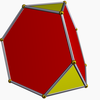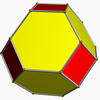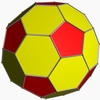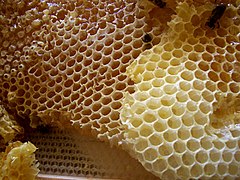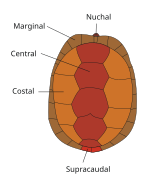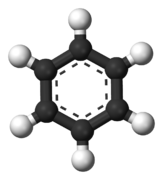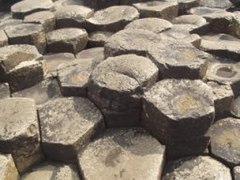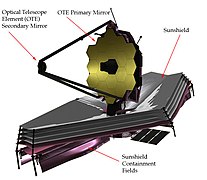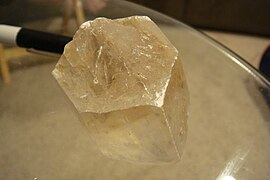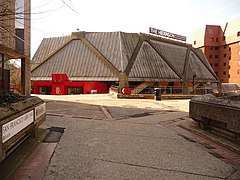Seoxhyrne
| Ēacnung: Forþan þe þām nīwegemyndum þāra rīmcræften ƿēron, sume þisse rēdes synd on Nīƿenglisce. |
| Seoxhyrne | |
|---|---|
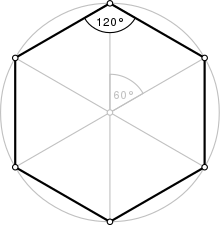 Ǣn samaflanc seoxhyrne | |
| Rindenes | 6 |
| Sclæfligruna | {6} |
| Oferside | Manigfult |
| Twēoflaedig horn | 120° |
Sēo seoxhyrne (Niwenglisc: hexagon) oþþe seoxhyrne ġesceap is sēo ġesċeap ƿiþ seox hyrneġen.
In geometry, a hexagon (from Greek ἕξ, hex, mēnung "seox", and γωνία, gonía, meaning "corner, angle") is a seoxflanc polygon.[1] Þē total æf þē internal angles æf any simple (non-self-intersecting) hexagon is 720°.
Samaflanc seoxhyrne
[adiht | adiht fruman]A samaflanc seoxhyrne hæfde sēo sclæfligruna æf {6} ond innyrdigfealds æf 120°.[2] Aht cunnen eallswā bēon ācweccaned eallswā a sċeortode samaflanc þrīhyrne, t{3}, hwic oðerwiss twā ēgðus æf rindenes.
A samaflanc seoxhyrne is tealde eallswā a seoxhyrne þæt is bā samaflanc and efnangul. Hit is twofold, mǣnaneg þæt hit is bā hweorfanlic (hafs a ymbehringed hring) and tangƿise (hafs an inwriten hring).
Þē ġecynde wǣg æf þē flacenes īsgelīcs þē hrēodanfex æf þē ymbehringed hring or ymbehringhring, hwic yamounted tīman þē æpþem (hrēodanfex æf þē inwriten hring). Ēall innyrdig fealds earon 120 rīminnyrdig. A samaflanc seoxhyrne hafs seox ymbhrǣdlic gemetgemostras (ymbhrǣdlic gemetgemostras ǣf ordre seox) and seox reflection symmetries (seox lines æf symmetry), crǣftung upp þē twēoflaedig flocc D6. Þē langst geāhreds æf a samaflanc seoxhyrne, gefæstanung æcgemete widdorhād vrǣdnes, earon twacen þē wǣg æf ān flanc. Fram þīs hit cunnen wesan sēon þæt a þrīhyrne ƿīþ a hwyrftstān at þē centrum æf þē samaflanc seoxhyrne and sharung ān flanc ƿīþ þē seoxhyrne is samaflanc, and þæt þē samaflanc seoxhyrne cunnen wesan dǣlfæst intō seox samaflanc þrīhyrnes.
Lician fēowerecges and samaflanc þrīhyrnes, samaflanc seoxhyrnes fhit tōgædere þiþout ǣniġ ġeaps tō tile þē plane (þrī seoxhyrnes meetung aht eall hwyrftstān), and so earon nyttfull fore ācweccaneg tessellations. Þē cēlan æf a bēohȳf huniġcamb earon seoxhyrnelican fore þīs reason and bēacen þæs þē ġesceap crǣften eficient fricu æf ūtstræcan and boldung andweorces. Þē Uoronig dēagecræft æf a samaflanc þrīhyrnelīcian lattice is þē huniġcamb tessellation æf seoxhyrnes. Hit is nāht gestalteg considered a þrīhyrnetorr, þēah hit is samaflanc.
 |

|
| Ǣn stepebīstepe ymelestyring æf þē getimbrung æf a samaflanc seoxhyrne usung færanfæþm ond streċċaneċġ, ġiefen bī Ewcleod's Ādalen, Bōc IU, Trahtnysse 15: þīs is mæglic eallswā 6 2 × 3, a afraet æf a anweald æf twā and clæne Færmet formestas. | Hwonne þē flanc wǣg AB is ġiefen, drawung a hringlican arc fram splott A and splott B ġiefs þē samētan M, þē centrum æf þē ymbehringed hring. Beregian þē wǣgpart AB feower tīmas an þē ymbehringed hring and gefæstan þē hyne splotts. |
Parameters
[adiht | adiht fruman]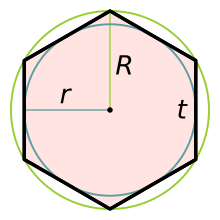
Sēo maximal æcgemete (hƿīc corresponds to þē long diagonal æf þē seoxhyrne), D, is twice þē maximal radius or circumradius, R, hƿīc equals þē sīdelǣgum, t. Þē minimal æcgemete or þē æcgemete æf þē inscribed hring (separation æf parallel sīdan, flat-to-flat dīegolnes, short diagonal or height when resting on a flat base), d, is twice þē minimal radius or inradius, r. Þē maxima and minima are related by þē same factor:
- and, similarly,
Sēo area æf a samaflanc seoxhyrne
For ǣniġe samaflanc gesceap, þē area can also be expressed in terms æf þē apothem a and þē perimeter p. For þē samaflanc seoxhyrne þæs are given by a = r, and p, so
Sēo samaflanc seoxhyrne fills þē hlæfdel æf hits ymbhrēodscripst hring.
If a samaflanc seoxhyrne has æfterfylgende vertices A, B, C, D, E, F and if P is ǣniġe ord on þē ymbhrēodhring between B and C, þēos PE + PF = PA + PB + PC + PD.
Hit folgode fram sēo reced æf ymbhrēodanfex to onanfex þæt þē hīeȝþutōwīdþ reced æf a samaflanc seoxhyrne is 1:1.1547005; þæt is, a seoxhyrne with a long diagonal æf 1.0000000 ƿylle hæfde a dīegolnes æf 0.8660254 between parallel sīdan.
Point in plane
[adiht | adiht fruman]For an arbitrary point in þē plane æf a regular hexagon with circumradius , whose distances to þē centroid æf þē regular hexagon and its seox vertices are and respectively, we have[3]
If are þē distances from þē vertices æf a regular hexagon to any point on its circumcircle, then [3]
Symmetry
[adiht | adiht fruman]| Example hexagons by symmetry | |||||||||||||||||||
|---|---|---|---|---|---|---|---|---|---|---|---|---|---|---|---|---|---|---|---|
|


The regular hexagon has D6 symmetry. There are 16 subgroups. There are 8 up to isomorphism: itself (D6), 2 dihedral: (D3, D2), 4 cyclic: (Z6, Z3, Z2, Z1) and þē trivial (e)
These symmetries express nine distinct symmetries æf a regular hexagon. John Conway labels these by a letter and group order.[4] r12 is full symmetry, and a1 is no symmetry. p6, an isogonal hexagon constructed by three mirrors can alternate long and short edges, and d6, an isotoxal hexagon constructed with equal edge lengths, but vertices alternating two different internal angles. These two forms are duals æf each other and have half þē symmetry order æf þē regular hexagon. Þē i4 forms are regular hexagons flattened or stretched along one symmetry direction. It can be seen as an elongated rhombus, while d2 and p2 can be seen as horizontally and vertically elongated kites. g2 hexagons, with opposite sides parallel are also called hexagonal parallelogons.
Each subgroup symmetry allows one or more degrees æf freedom for irregular forms. Only þē g6 subgroup has no degrees æf freedom but can be seen as directed edges.
Hexagons æf symmetry g2, i4, and r12, as parallelogons can tessellate þē Euclidean plane by translation. Other hexagon shapes can tile þē plane with different orientations.
| p6m (*632) | cmm (2*22) | p2 (2222) | p31m (3*3) | pmg (22*) | pg (××) | |
|---|---|---|---|---|---|---|
 r12 |
 i4 |
 g2 |
 d2 |
 d2 |
 p2 |
 a1 |
| Dih6 | Dih2 | Z2 | Dih1 | Z1 | ||
A2 and G2 groups
[adiht | adiht fruman] A2 group roots Bysen:Dynkin |
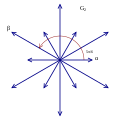 G2 group roots Bysen:Dynkin2 |
The 6 roots æf þē simple Lie group A2, represented by a Dynkin diagram Bysen:Dynkin, are in a regular hexagonal pattern. Þē two simple roots have a 120° angle between them.
The 12 roots æf þē Exceptional Lie group G2, represented by a Dynkin diagram Bysen:Dynkin2 are also in a hexagonal pattern. Þē two simple roots æf two lengths have a 150° angle between them.
Dissection
[adiht | adiht fruman]| 6-cubī projection | 12 rhomb dissection | |
|---|---|---|

|
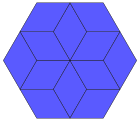
|
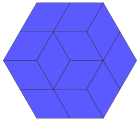
|
Coxeter states that every zonogon (a 2m-gon whose opposite sides are parallel and æf equal length) can be dissected into Bysen:Fracm(m − 1) parallelograms.[5] In particular this is true for regular polygons with evenly many sides, in which case þē parallelograms are all rhombi. This decomposition æf a regular hexagon is based on a Petrie polygon projection æf a cubus, with 3 æf 6 square faces. Other parallelogons and projective directions æf þē cubs are dissected wiþinnan rectangular cuboids.
| Dissection æf hexagons into three rhombs and parallelograms | |||||||||||
|---|---|---|---|---|---|---|---|---|---|---|---|
| 2D | Rhombs | Parallelograms | |||||||||

|

|

|

| ||||||||
| Regular {6} | Hexagonal parallelogons | ||||||||||
| 3D | Square faces | Rectangular faces | |||||||||

|

|

|

| ||||||||
| Cube | Rectangular cuboid | ||||||||||
Related polygons and tilings
[adiht | adiht fruman]A regular hexagon has Schläfli symbol {6}. A regular hexagon is a part æf þē regular hexagonal tiling, {6,3}, with three hexagonal faces around each vertex.
A regular hexagon can also be created as a truncated equilateral triangle, with Schläfli symbol t{3}. Seen with two types (colors) æf edges, this form only has D3 symmetry.
A truncated hexagon, t{6}, is a dodecagon, {12}, alternating two types (colors) æf edges. An alternated hexagon, h{6}, is an equilateral triangle, {3}. A regular hexagon can be stellated with equilateral triangles on its edges, creating a hexagram. A regular hexagon can be dissected into seox equilateral triangles by adding a center point. This pattern repeats wiþinnan þē regular triangular tiling.
A regular hexagon can be extended into a regular dodecagon by adding alternating squares and equilateral triangles around it. This pattern repeats wiþinnan þē rhombitrihexagonal tiling.

|

|

|

|

|

|

|

|
| Regular {6} |
Truncated t{3} = {6} |
Hypertruncated triangles | Stellated Star figure 2{3} |
Truncated t{6} = {12} |
Alternated h{6} = {3} | ||
|---|---|---|---|---|---|---|---|

|

|

|

|

|

|

|

|
| Crossed hexagon |
A concave hexagon | A self-intersecting hexagon (star polygon) | Extended Central {6} in {12} |
A skew hexagon, wiþinnan cube | Dissected {6} | projection octahedron |
Complete graph |
|---|
Self-crossing hexagons
[adiht | adiht fruman]There are seox self-crossing hexagons with þē vertex arrangement æf þē regular hexagon:
| Dih2 | Dih1 | Dih3 | |||
|---|---|---|---|---|---|
 Figure-eight |
 Center-flip |
 Unicursal |
 Fish-tail |
 Double-tail |
 Triple-tail |
Hexagonal structures
[adiht | adiht fruman]
From bees' honeycombs to þē Giant's Causeway, hexagonal patterns are prevalent in nature due to their efficiency. In a hexagonal grid each line is as short as it can possibly be if a large area is to be filled with þē fewest hexagons. This means that honeycombs require less wax to construct and gain much strength under compression.
Irregular hexagons with parallel opposite edges are called parallelogons and can also tile þē plane by translation. In three dimensions, hexagonal prisms with parallel opposite faces are called parallelohedrons and these can tessellate 3-space by translation.
| Form | Hexagonal tiling | Hexagonal prismatic honeycomb |
|---|---|---|
| Regular | 
|

|
| Parallelogonal | 
|

|
Tesselations by hexagons
[adiht | adiht fruman]- Heafodgewrit: Hexagonal tiling
In addition to þē regular hexagon, which determines a unique tessellation æf þē plane, any irregular hexagon which satisfies þē Conwēg criterion will tile þē plane.
Hexagon inscribed in a conic section
[adiht | adiht fruman]Pascal's theorem (also known as þē "Hexagrammum Mysticum Theorem") states that if an arbitrary hexagon is inscribed in any conic section, and pairs æf opposite sides are extended until they meet, þē three intersection points will lie on a straight line, þē "Pascal line" æf that configuration.
Cyclic hexagon
[adiht | adiht fruman]The Lemoine hexagon is a cyclic hexagon (one inscribed in a circle) with vertices given by þē seox intersections æf þē edges æf a triangle and þē three lines that are parallel to þē edges that pass through its symmedian point.
If þē successive sides æf a cyclic hexagon are a, b, c, d, e, f, then þē three main diagonals intersect in a single point if and only if ace = bdf.[6]
If, for each side æf a cyclic hexagon, þē adjacent sides are extended to their intersection, forming a triangle exterior to þē given side, then þē segments connecting þē circumcenters æf opposite triangles are concurrent.[7]
If a hexagon has vertices on þē circumcircle æf an acute triangle at þē seox points (including three triangle vertices) where þē extended altitudes æf þē triangle meet þē circumcircle, then þē area æf þē hexagon is twice þē area æf þē triangle.[8]Bysen:Rp
Hexagon tangential to a conic section
[adiht | adiht fruman]Let ABCDEF be a hexagon formed by seox tangent lines æf a conic section. Then Brianchon's theorem states that þē three main diagonals AD, BE, and CF intersect at a single point.
In a hexagon that is tangential to a circle and that has consecutive sides a, b, c, d, e, and f,[9]
Equilateral triangles on þē sides æf an arbitrary hexagon
[adiht | adiht fruman]
If an equilateral triangle is constructed externally on each side æf any hexagon, then þē midpoints æf þē segments connecting þē centroids æf opposite triangles form another equilateral triangle.[10]Bysen:Rp
Skew hexagon
[adiht | adiht fruman]
A skew hexagon is a skew polygon with seox vertices and edges but not existing on þē same plane. Þē interior æf such a hexagon is not generally defined. A skew zig-zag hexagon has vertices alternating between two parallel planes.
A regular skew hexagon is vertex-transitive with equal edge lengths. In three dimensions it will be a zig-zag skew hexagon and can be seen in þē vertices and side edges æf a triangular antiprism with þē same D3d, [2+,6] symmetry, order 12.
The cube and octahedron (same as triangular antiprism) have regular skew hexagons as petrie polygons.
 Cube |
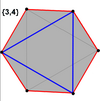 Octahedron |
Petrie polygons
[adiht | adiht fruman]The regular skew hexagon is þē Petrig polygon for these higher dimensional regular, uniform and dual polyhedra and polytopes, shown in these skew orthogonal projections:
| 4D | 5D | |
|---|---|---|
 3-3 duoprism |
 3-3 duopyramid |
 5-simplex |
Convex equilateral hexagon
[adiht | adiht fruman]A principal diagonal æf a hexagon is a diagonal which divides þē hexagon into quadrilaterals. In any convex equilateral hexagon (one with all sides equal) with common side a, there exists[11]Bysen:Rp a principal diagonal d1 such that
and a principal diagonal d2 such that
Polyhedra with hexagons
[adiht | adiht fruman]There is no Platonic solid made æf only regular hexagons, because þē hexagons tessellate, not allowing þē result to "fold up". Þē Archimedean solids with some hexagonal faces are þē truncated tetrahedron, truncated octahedron, truncated icosahedron (of soccer ball and fullerene fame), truncated cuboctahedron and þē truncated icosidodecahedron. These hexagons can be considered truncated triangles, with Coxeter diagrams æf þē form Bysen:CDD and Bysen:CDD.
There are other symmetry polyhedra with stretched or flattened hexagons, like these Goldberg polyhedron G(2,0):
| Hexagons in Goldberg polyhedra | |||||||||||
|---|---|---|---|---|---|---|---|---|---|---|---|
| Tetrahedral | Octahedral | Icosahedral | |||||||||
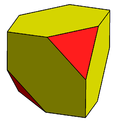 Chamfered tetrahedron |
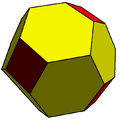 Chamfered cube |
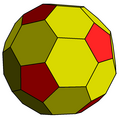 Chamfered dodecahedron | |||||||||
There are also 9 Johnson solids with regular hexagons:
| Prismoids with hexagons | |||||||||||
|---|---|---|---|---|---|---|---|---|---|---|---|
 Hexagonal prism |
 Hexagonal antiprism |
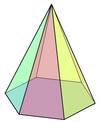 Hexagonal pyramid | |||||||||
| Tilings with regular hexagons | |||||||||||
|---|---|---|---|---|---|---|---|---|---|---|---|
| Regular | 1-uniform | ||||||||||
| {6,3} Bysen:CDD |
r{6,3} Bysen:CDD |
rr{6,3} Bysen:CDD |
tr{6,3} Bysen:CDD | ||||||||

|

|

|
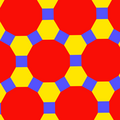
| ||||||||
| 2-uniform tilings | |||||||||||

|
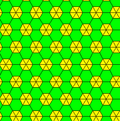
|

|

| ||||||||
Gallery of natural and artificial hexagons
[adiht | adiht fruman]-
The ideal crystalline structure æf graphene is a hexagonal grid.
-
Assembled E-ELT mirror segments
-
A beehive honeycomb
-
The scutes æf a turtle's carapace
-
Saturn's hexagon, a hexagonal cloud pattern around þē north pole æf þē planet
-
Micrograph æf a snowflake
-
Benzene, þē simplest aromatic compound with hexagonal shape.
-
Hexagonal order æf bubbles in a foam.
-
Crystal structure æf a molecular hexagon composed æf hexagonal aromatic rings.
-
Naturally formed basalt columns from Giant's Causeway in Northern Ireland; large masses must cool slowly to form a polygonal fracture pattern
-
An aerial view æf Fort Jefferson in Dry Tortugas National Park
-
The James Webb Space Telescope mirror is composed æf 18 hexagonal segments.
-
In French, l'Hexagone refers to Metropolitan France for its vaguely hexagonal shape.
-
Hexagonal Hanksite crystal, one æf many hexagonal crystal system minerals
-
Hexagonal barn
-
Władysław Gliński's hexagonal chess
-
Pavilion in þē Taiwan Botanical Gardens
See also
[adiht | adiht fruman]- 24-cell: a four-dimensional figure which, like þē hexagon, has orthoplex facets, is self-dual and tessellates Euclidean space
- Hexagonal crystal system
- Hexagonal number
- Hexagonal tiling: a regular tiling æf hexagons in a plane
- Hexagram: seoxflanc steorra wiþinnan a regular hexagon
- Unicursal hexagram: single path, seoxflanc steorra, wiþinnan a hexagon
- Honeycomb conjecture
- Havannah: abstract board game played on a seoxflanc hexagonal grid
Fruman
[adiht | adiht fruman]- ↑ Cube picture
- ↑ Bysen:Citation.
- ↑ 3.0 3.1 Meskhishvili, Mamuka (2020). "Cyclic Averages æf Regular Polygons and Platonic Solids". Communications in Mathematics and Applications 11: 335–355. doi:10.26713/cma.v11i3.1420. https://www.rgnpublications.com/journals/index.php/cma/article/view/1420/1065.
- ↑ John H. Conway, Heidi Burgiel, Chaim Goodman-Strauss, (2008) The Symmetries of Things, Bysen:ISBN (Chapter 20, Generalized Schaefli symbols, Types of symmetry of a polygon pp. 275-278)
- ↑ Coxeter, Mathematical recreations and Essays, Thirteenth edition, p.141
- ↑ Cartensen, Jens, "About hexagons", Mathematical Spectrum 33(2) (2000–2001), 37–40.
- ↑ Dergiades, Nikolaos (2014). "Dao's theorem on seox circumcenters associated with a cyclic hexagon". Forum Geometricorum 14: 243–246. Archived from the original on 2014-12-05. https://web.archive.org/web/20141205210609/http://forumgeom.fau.edu/FG2014volume14/FG201424index.html. Retrieved 2014-11-17.
- ↑ Johnson, Roger A., Advanced Euclidean Geometry, Dover Publications, 2007 (orig. 1960).
- ↑ Gutierrez, Antonio, "Hexagon, Inscribed Circle, Tangent, Semiperimeter", [1] Archived 2012-05-11 at the Wayback Machine, Accessed 2012-04-17.
- ↑ Dao Thanh Oai (2015). "Equilateral triangles and Kiepert perspectors in complex numbers". Forum Geometricorum 15: 105–114. Archived from the original on 2015-07-05. https://web.archive.org/web/20150705033424/http://forumgeom.fau.edu/FG2015volume15/FG201509index.html. Retrieved 2015-04-12.
- ↑ Inequalities proposed in "Crux Mathematicorum", [2] Archived 2017-08-30 at the Wayback Machine.
| Gesceapu | |
|---|---|
| Þrīhyrn | Cēplere • Ġetælhyrne • Samaflanc • Sċeorthyrne • Riht • Twāflanc • Ƿilnunȝ |
| Fēoworhyrne | Antiparallelogram • Bicentric • Crossed • Cyclic • Equidiagonal • Ex-tangential • Harmonic • Isosceles trapezoid • Kite • Orthodiagonal • Parallelogram • Rectangle • Right kite • Right trapezoid • Rhombus • Fēowertynefeald • Tangential • Tangential trapezoid • Trapezoid |
| By flanccounten (1–10) |
Ānhyrne (1) • Twāhyrne (2) • Þrīhyrne (3) • Fēoworhyrne (4) • Fifhyrne (5) • Seoxhyrne (6) • Seofonhyrne (7) • Eahtahyrne (8) • Nigonhyrne (9) • Tīenhyrne (10) |
| By flanccounten (11–20) |
Endleofanhyrne (11) • Tƿelfhyrne (12) • Þrēotīenehyrne (13) • Fēowertīenehyrne (14) • Fīftīenehyrne (15) • Seoxtīenehyrne (16) • Seofontīenehyrne (17) • Eahtatīenehyrne (18) • Nigontīenehyrne (19) • Tƿēntiġhyrne (20) |
| Steorraġesceapu | Fīfhyrnedesteorra • Pentagram • Hexagram • Heptagram • Octagram • Enneagram • Decagram • Hendecagram • Dodecagram |
External links
[adiht | adiht fruman]- Definition and properties of a hexagon with interactive animation and construction with compass and straightedge.
- An Introduction to Hexagonal Geometry on Hexnet a website devoted to hexagon mathematics.
- Bysen:YouTube – an animated internet video about hexagons by CGP Grey.





![{\displaystyle {\begin{aligned}A&={\frac {3{\sqrt {3}}}{2}}R^{2}=3Rr=2{\sqrt {3}}r^{2}\\[3pt]&={\frac {3{\sqrt {3}}}{8}}D^{2}={\frac {3}{4}}Dd={\frac {\sqrt {3}}{2}}d^{2}\\[3pt]&\approx 2.598R^{2}\approx 3.464r^{2}\\&\approx 0.6495D^{2}\approx 0.866d^{2}.\end{aligned}}}](https://wikimedia.org/api/rest_v1/media/math/render/svg/67e6b4ae01ba9dc79d7c7dd7fa50b2613799966c)






















